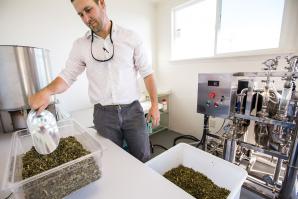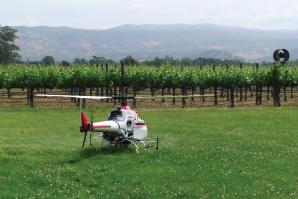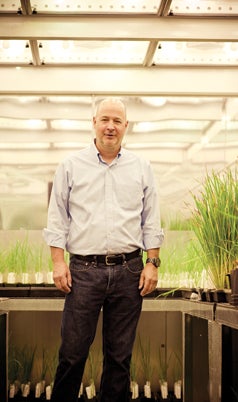A few months after the 2002 launch of Arcadia Biosciences Inc. in Phoenix, CEO Eric Rey insisted the company move to California. Not to Silicon Valley, but to Davis.
Research happening at UC Davis fit well with Arcadia’s mission to develop crops that yield more with less water and less reliance on nitrogen fertilizer. One project aims at plants that would thrive on saltwater.
Another would produce low-gluten wheat for people with intolerance for the protein.
“In our years of existence, we spent almost no money on recruiting and very little on relocation because we get a tremendous number of people who come out of UC Davis,” Rey says. “We find plenty of good talent. It is relatively infrequently that we are doing recruiting out of the area.”
Silicon Valley may have the geeky glitz, but the Central Valley brings a lot to the table too. California agriculture is a nearly $36.6 billion industry, according to the California Department of Food and Agriculture. Food processing adds $50 billion to that total. The state’s 88,000 farms and ranches grow more than half of the nation’s fruits, vegetables and nuts and produce about $5 billion worth of milk to wash it down.
If a strawberry doesn’t sound especially high-tech, consider that the Camarosa variety alone generated $2.2 million in royalty and fee income last year for UC Davis through its technology transfer office.
“The ways in which breeders go about selecting varieties is changing with the application of genomics and molecular markers. There are new ways that breeders look at how traits are going to be transmitted and the genes involved,” says William Tucker, executive director of Innovation Alliances and Services for the University of California system.
Strawberries can now grow from Baja California to the northern part of the state, something that never happened in nature. Sixty percent of strawberries consumed in California are UC Davis varieties. The crop has become nearly a $2 billion business in California largely because of breeding programs and horticultural practices developed at UC Davis, transferred to the field through its Ag Extension program.
UC Davis also has taken a lead in neutraceuticals, or foods that provide a particular health benefit. Tomatoes high in lycopene, for example, may help reduce the risk of prostate cancer.
“Some of it is not sexy technology like you might think of in Silicon Valley, but they are absolutely essential to the success of California agriculture,” Tucker says. “You are looking at things like vaccines if you are looking at animal productivity; you can talk about mechanization as not only a part of the farming enterprise but also post-harvest; there’s a lot of work being done on keeping flowers fresh longer.”
But the ag industry is rather stealthy about its innovations, says Charlie Blackburn, CEO of Trinity Venture Capital in Lodi. He cites development such as remote radio-frequency moisture and nutrient management systems that download information via satellite to a farm manager’s smart phone. New production and harvesting equipment is GPS equipped for precise mapping of fields, helping farmers maximize planting and production for a given acreage.
“The obvious innovations are methane fuel production on dairies from their own waste, allowing many dairies to largely become self-powered,” Blackburn says.
But while software has a hub in Silicon Valley, agricultural technology hasn’t coalesced around any one place. Rey identifies several hubs: Davis/Sacramento for projects that are primarily ag biotech, and the Bay Area and San Diego for projects that have ag biotech elements as a subset of something larger.
Creating one California hub for agricultural technology is a tall order.
“With a state a thousand miles long and ecosystems ranging from rain forests to arid deserts, and cropping patterns affiliated with all those things, you will not find a single location to do what needs to be done,” says Don Klingborg, who directs the advocacy and county partnerships effort at the University of California Division of Agriculture and Natural Resources. That’s why the university has nine extension centers across the state — someone needs to make sure that the ideas that come out of campus labs will actually work in the field.
“Once it has gone through that and you have done the fine-tuning, then it is time to do the transfer into the private sector,” Klingborg says.
Even as the traditional ag school, UC Davis has competition. While UC Davis hosts the Postharvest Technology Center, California State University, Fresno, is home to the California Agricultural Technology Institute. And UC Riverside is doing for oranges what UC Davis did for strawberries.
One effort is attracting new attention to the Sacramento region as an ag tech hub. Grow California, a spinoff of the Golden Capital Network in Chico, held its first California Agriculture Innovation Conference in Davis in July. Sponsorship partners included the Sacramento Area Regional Technology Alliance.
“What we are attempting to do is identify those California companies that have an innovative product that can be a game-changer,” says Jon Gregory, CEO of Grow California. “It might be in food safety, in the pre-harvest or post-harvest stage. It might be in software to better manage distribution of products. It might be a new piece of equipment that provides for better processing. It might be a better irrigation management technology to save water, which also has an impact on energy use.”
The two-day conference was billed as the first time the Silicon Valley would be focusing on the Central Valley and beyond for potential investment opportunities in agriculture.
As Grow California’s promotional material states: “Conference organizers believe that by bringing the venture capital community together with the agricultural community, there will be tremendous potential to create an innovative technology hub for agriculture in the Central Valley as was done in the Silicon Valley for high tech.”
By bringing together players in multiple arenas, the conference might even have sparked some deals, though Gregory doesn’t expect to see anything happen before the end of this year.
“What I am trying to do is make sure the startup in Clovis gets connected to the big farm in Woodland, and they get connected to the CEO of a big wholesaler or retailers that might be in San Francisco or L.A.,” Gregory says.
As for why ag technology needs a boost in the first place, Gregory sees several reasons: Food products are such an integral part of everyday life, they are taken for granted. Second, agriculture has an image of being slow to change.
“No. 3, it doesn’t get the innovation investment headlines that the Googles of the world do. The venture capital interest in agriculture is at a very nascent stage,” he says.
Until now, the corporate side of agricultural innovation has come out of large companies such as Monsanto Co. and The Dow Chemical Co. Venture funds have concentrated on sectors already familiar to them, such as computer hardware, software, medical devices and pharmaceutical products.
That’s part of the problem, but only part, says Joe Hudson, managing director of One Earth Capital in San Francisco. It has invested in several ag tech companies, including Marrone Bio Innovations Inc. in Davis.
It’s true that venture capitalists like to stick with what they know, he says. The software investors have felt some pain in areas such as biofuels and solar electricity. The venture capital profession as a whole is more cautious about jumping into a new area like agriculture.
“The pros of agriculture and venture capital are that it is not a very technologically advanced market, so there is a lot of opportunity and it is a huge market. You can create very sizable companies, in theory,” he says. “The bad news is that VCs really like high-margin businesses, and ag is not notably a high-margin business.”
“The bad news is that VCs really like high-margin businesses,
and ag is not notably a high-margin business.”Joe Hudson, managing director, One Earth Capital
Half of all VC portfolio companies fail, so the other half must produce a lot of profit to make up for that. They also want companies that can grow quickly, so there can be a quicker exit through acquisition or going public.
Venture capitalists will risk millions on pharmaceuticals, which can take more than a decade to develop and bring to market. But the equation is more favorable than agriculture.
“One thing is that you know exactly the market in pharmaceuticals. If I can create a drug that does this, I can get this much market penetration. You don’t have that kind of clarity in agriculture,” Hudson says. One big exception in agriculture involves seeds. “I know if I can create a seed with a 30 percent yield increase, I will have X market penetration.”
And so far, those are the only kinds of companies that have seen highly profitable exits. Once other areas of ag technology start earning a lot of money for their owners, the venture capitalists will start storming the gates, he says. The industry is closely watching Ceres Inc., a seed company in Thousand Oaks that has registered for an initial public offering of stock.
“The other thing is, people in the ag space are both unfamiliar with and leery of the venture capital business model,” Hudson says.
Then there is the problem of recruiting talent for a portfolio company.
“I’m going to get a CFO who has worked for a public company, and I’m going to ask them to move to Chico?” Hudson asks. “World-class talent is more likely to gravitate toward San Francisco than Firebaugh.”
UC Davis could become a hub for ag tech in the same way Stanford has for Silicon Valley, but so far the university hasn’t realized its full potential.
“The technology-transfer person is only one aspect,” Hudson says. “What I know is that they are actively working on it. They are learning. They are trying to figure it out, but the industry just isn’t mature. And I think part of it is the nature of agriculture, frankly.”
One Earth’s portfolio company in Davis, Marrone Bio Innovations, didn’t sprout from the university. Founder Pam Marrone came from an earlier ag tech venture, AgraQuest, which she founded in Davis in 1995. She raised more than $50 million in venture capital for the company before leaving in 2006 and was able to get several natural pest management products on the market.
In the five years her new company has been around, it has developed a line of biopesticides for markets around the globe. Two more were approved by the Environmental Protection Agency this summer, two were pending, and several more were in the pipeline.
It takes three or more years to get a product developed, through the EPA and onto the market, at a cost of $3 million to $5 million.
In June Marrone landed $24.5 million in Series C private financing.
“My experience at AgraQuest taught me a lot. It’s really important to select your investors who share chemistry for the founders,” she says. “Ag is not for the faint of heart. It is different. It is not an iPod. It is very technical, and there are a lot of parts to it.”
Gregory of Grow California sees the big challenge as finding the right investment model. “I think clean tech has had a ton of hype in the last eight to 10 years, with tons of investment going into the industry, but in many ways there are still questions,” he says. Investors need to agree on formulas for evaluation and more realistic expectations for returns.
Farmers like to take it slow with innovations, Gregory says. They’d rather test something on 50 acres than 2,000. They like it even more if a neighboring farmer will test it first. That can slow down adoption.
Farmers are like any other business people, says Rey of Arcadia Biosciences. “They don’t want to spend money unless they are spending money to make money. The rule of thumb in the industry is if you create a dollar of value for a farmer, a farmer is not going to give up more than 50 cents to get it.”
Developing commodities with benefits in Davis
Arcadia Biosciences Inc. is revolutionizing natural foods.
The Davis-based company is generating beets and rice that can thrive on less fertilizer, less water and even salty water. Other projects involve the creation of safflower oil containing an anti-inflammatory fatty acid that can suppress asthma and eczema, and the development of wheat safe for gluten-intolerant consumers.
Ten-year-old Arcadia has even caught the attention of Monsanto Co., which signed a licensing agreement to commercialize a variety of canola. Arcadia also has sold or licensed some of its products in Canada, India, Africa and Australia.
Revenue has grown to “multiple millions,” but Arcadia hasn’t yet hit profitability. The big money behind Arcadia’s startup came from John Sperling, founder of the University of Phoenix.
“Arcadia came about out of conversations that he and I had, discussions about what really constitutes sustainability in the context of products and activities that are good for the environment,” says president and CEO Eric Rey. “John and I had — and still have — the same sort of view: In order for something to be truly sustainable in the world today, there probably has to be a profit motive in it.”
Along the way, venture investors have included Exeter Life Sciences Inc., CMEA Ventures, BASF Venture Capital America Inc. and Saints VC. Arcadia also has been adept at landing grants and federal contracts from organizations not always associated with food, including the National Institutes For Health, the Defense Department and the Department of Homeland Security.
The armed forces buy a lot of produce for U.S. troops, and some of it is inevitably lost to spoilage. Arcadia worked on a $2.9 million project with the Department of Defense to extend the shelf life of lettuce and tomatoes. Now the company is trying to get commercial seed companies interested.
There is no quick path to riches in crop work. Development cycles typically run at least seven years, and the company itself is only 11 years old. The staff has grown to about 90 people, with satellite offices and field research in Seattle, Phoenix and Idaho.
“We’ve never gone through huge growth spurts. Most of it has been slow and steady,” Rey says. He recalls an earlier part of his career with another Davis company, Calgene, which would go through large swings of hiring and layoffs. A more stable approach lets people concentrate more on their work than their resumes, he says.
Just as there is a profit motive behind Arcadia, there is a realization that its products need to offer a financial benefit to customers.
“What we really want to do is present farmers with this clear
economic motivation: You are going to make more money,” Rey says.
“Of course, we want a small piece of it.”
Recommended For You

Sugar & Splice
The Capital Region offers everything nice for ag-bio companies like Stevia First
A Capital Region startup is striving to be among the first in the nation to produce the zero-calorie, natural sweetener stevia on an industrial scale. An agricultural biotech company, Yuba City-based Stevia First is bolstering its chances of success by actively collaborating with experts in the field, drawing on the area’s robust talent pool of farmers, agronomists, agricultural innovators and biotech experts to develop a product that’s superior in both taste and cost compared to its foreign competitors.

The Robots are Coming
Technologies of tomorrow are making their way onto the crop fields of today
Scientists, engineers and entrepreneurs are racing to give farmers tools to boost agricultural productivity. These five technologies — some big, some small — could change the face of farming.




